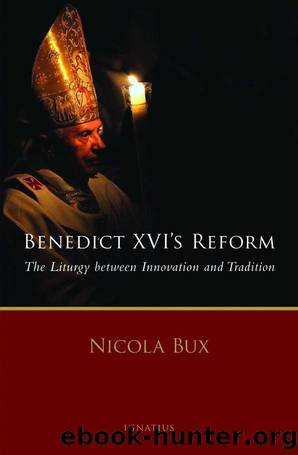Benedict XVI's Reform by Nicola Bux

Author:Nicola Bux [Bux, Nicola]
Language: eng
Format: epub
Tags: Spiritual & Religion
ISBN: 9781586174460
Publisher: Ignatius Press
Published: 2012-05-08T16:00:00+00:00
V
THE ECCLESIAL CRISIS AND THE
DISINTEGRATION OF THE LITURGY
Ecclesial and Liturgical Continuity
According to some, the motu proprio Summorum pontificum of Benedict XVI, which once again permits the celebration of the so-called âTridentine Riteâ, runs the risk of creating âupheavalâ because the ecclesiology of the old Missal is supposedly âincompatibleâ with that of Vatican II; a bishop has spoken of the motu âimproprioâ. Let us consider the validity of such a thesis, taking up the Roman Canon, the Eucharistic Prayer that has remained in the Missal of Paul VI. In it, the priest turns in the first place to the Father and presents the offering âfor the holy catholic Churchâ so that she might be gathered together in unityâas is also prayed in the ancient Didacheâand so that he might lead it through the pope, the bishop, and âall those who keep and cultivate the orthodox and catholic faith handed down by the apostlesâ, that is, the legitimate pastors of the particular churches and local communities. They are the celebrated marks that prove the existence of communion in the Church. At the same time, the priest remembers to the Father those who are present at the celebration and make their offering: âfor them we offer to you and they too offerâ, that is, the offering is made by the ordained priesthood and the common priesthood. In the second place, it is stated that the Mass is celebrated in communion with Mary and the saints, the heavenly Church, asking their intercession. In the third place, âthe powerâ of Godâs âbenedictionâ is invoked so that the gifts might be consecrated: the expression is referred to the Holy Spirit. Historical research has suggested that the nucleus of the Roman Canon dates to before the definition by the Council of Constantinople in 381. This should not be surprising, since another ancient Eucharistic Prayer, the Coptic anaphora of Serapion, contains an epiclesis to the Word.
Returning to the Roman Canon, after the Consecration, the priest calls to mind the Father of the Son and the Sonâs Paschal Mystery, offering his body and his blood as an acceptable sacrifice prefigured by those of Abel, Abraham, and Melchizedek; he pleads for the sacrifice to reach the heavenly altar from the earthly one. Then follow the intercessions for the dead, for the purification of the Church, and for the earthly Church that is celebrating in that place. The great prayer concludes with the glorification of the Trinity and the amen of the faithful.
From this prayer, which carefully weaves together personal and communitarian faith, emerges the communion of the Church that descends from heaven with the marks of unity, sanctity, catholicity, and apostolicity. The prayer simultaneously remembers Jesus Christ and his mystery and awaits his coming both in the liturgical present and in the final judgment. Thus the liturgy and the Church are manifested as the memory of the historical event of Christ that took place in the Holy Land two thousand years ago with the Incarnation and redemption but that is ever present in the mystery of faith and charity that is especially the Eucharist.
Download
This site does not store any files on its server. We only index and link to content provided by other sites. Please contact the content providers to delete copyright contents if any and email us, we'll remove relevant links or contents immediately.
Resisting Happiness by Matthew Kelly(3270)
The Social Psychology of Inequality by Unknown(2908)
Day by Elie Wiesel(2695)
Designing Your Life by Bill Burnett(2623)
The Giving Tree by Shel Silverstein(2223)
Angels of God: The Bible, the Church and the Heavenly Hosts by Mike Aquilina(1905)
Human Design by Chetan Parkyn(1894)
The Supreme Gift by Paulo Coelho(1863)
Jesus of Nazareth by Joseph Ratzinger(1744)
Augustine: Conversions to Confessions by Robin Lane Fox(1716)
Hostage to the Devil by Malachi Martin(1712)
7 Secrets of Divine Mercy by Vinny Flynn(1660)
Dark Mysteries of the Vatican by H. Paul Jeffers(1646)
The Vatican Pimpernel by Brian Fleming(1619)
St. Thomas Aquinas by G. K. Chesterton(1585)
Saints & Angels by Doreen Virtue(1556)
The Ratline by Philippe Sands(1472)
My Daily Catholic Bible, NABRE by Thigpen Edited by Dr. Paul(1446)
Called to Life by Jacques Philippe(1432)
